Dairy Foams
When gasses like oxygen (H₂O) or nitrous oxide (N₂O) are injected into milk or cream, foams of different textures are created. Dairy foams happen because whey and casein in the milk protein become denatured, forming a thin film that traps the gas and creates bubbles. Foams may be light and airy bubbles, frothy or dense, or thick like an espuma. Whether you are making hot varieties accompanying coffee drinks or cold dessert creams, temperature, and fat content are critical factors in creating foams.
Heavy cream with 30-40% butterfat forms a stable cold foam because the fat surrounds the denatured proteins and holds the air in place. But whipped cream will quickly fall if it gets too warm. Stabilizers, including lecithin, agar, gelatin, and xanthan gum, can be added to foams for greater volume and steadiness.
Foams made with milk are less stable than cream and don't hold up as well unless combined with stabilizers. Fat-free (skim) milk creates better bubbles than whole milk at 3-4%. That's because, in fat-free milk, the proteins do all the work; in whole milk, the small amount of fat works against bubble creation. Skim milk foams the best at 110°F/45 °C, but as the heat increases, the fat content in whole milk helps it create a similar volume.
Foaming Cream with a Siphon
Foams are aerated through the use of a whisk, either by hand, in a mixer, or with an immersion blender. Cream can also be foamed with a nitrous oxide (N₂O) charger, called a thermal whip or a whipping siphon. Cream doubles in volume when whipped by hand or with a mixer but will increase by about four times its volume if it is foamed with a gas.
Conventional Whipped Cream
It’s essential to keep the cream and the utensils (bowl and whisk) as cold as possible, below 40°F/4°C, when aerating. A balloon whisk will achieve the most volume. Sugar stabilizes the cream but prevents it from achieving full volume, so add it towards the end of the process as it begins to hold soft peaks. Flavor with vanilla, cocoa powder, or other flavorings as desired. Some weeping may occur if it is whipped in advance, and stabilizers such as gelatin (1 tsp. gelatin melted in 2 tsp. water per cup of cream) or dried milk powder (2 tsp. per 1 cup of cream) may be added to the whipped cream. Cream that is slightly over-whipped and beginning to look grainy can be brought back by adding a touch of un-whipped cream. If the cream has been whipped to the point of butter, it cannot be brought back.
Preparation Method
Step 1
Cream doubles in volume when whipped by hand or with a mixer but will increase by about four times its volume if it is foamed with a gas.
Chill the bowl and whisk in a cooler or freezer before beginning the process.
Add the cream to the bowl and begin to whisk
Add milk powder at this stage if using to stabilize the cream
Step 2
If using a machine, begin slowly until it starts to thicken, and then increase the speed to medium. Whipping by hand should take 3-5 minutes of vigorous whipping. Monitor it carefully, especially if using a machine, to avoid over-whipping the cream.
Whip to a soft peak
Add sugar if desired
Add a little melted gelatin to stabilize if desired
Foaming Cream with a Charger
Cream can also be foamed using a nitrous oxide charger.
Step 1
Add the cream to the charger
Step 2
Fit a tip onto the cover of the charger and tighten it to the tank
Charge the tank with a cartridge
Step 3
Shake the charger a few times
Invert and squeeze the handle
Hand Whipped
Machine Whipped
N₂O Charger





